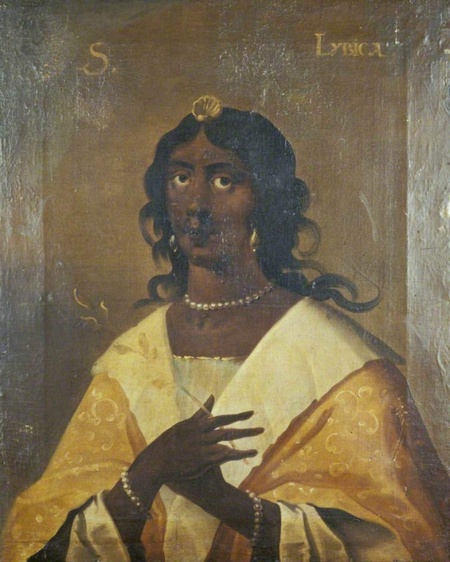In 1641, twelve paintings representing the Sibyls were gifted to King’s College by Principal William Guild. A receipt found in the archives implied the identity of the original artist to be George Jamesone (Pryor 2002:61) but affirmed that during the 18th century the works had been restored and repainted by the artist Cosmo Alexander. The term sibyl comes from the ancient Greek word ‘sibylla’, meaning prophetess. Later, in Christian art, the Sibyls were deemed to be foretellers of the Christian Revelation and were represented as young women who were blessed with the gift of prophesying the birth and life of Christ.
While working on the Art collection, I became interested in two of the portraits, one that represents Aegyptiaca and another that represents Lybica.
In 2002 Pryor (121) wrote “Sibyl Lybica (or Lybia) usually holds a candle or a torch because she foretold that the Light of the World would shine in the darkness. In this version Sibyl Lybica holds an olive branch in her right hand as a symbol of peace. She also wears a scallop shell with a pearl in her hair. Christians adopted the scallop as the symbol of pilgrims, and it may be as a reference to this that Lybica is adorned with the shell.
Pryor describes the portrait in its 18th-century rendition, noting that “Lybica’s opaque dark skin-tones are heavily applied and mask what are evidently Western features, including the ‘rosebud’ lips. The apparent addition of scrolled patterning to her dress and the various items of pearl and gold jewellery combine to render considerable decorative and ‘exotic’ effect. “(2002:121).
In the eyes of Jamesone/Alexander, although representing imaginary figures and not real individuals, the sibyl representing Egypt or Sibyl Aegyptiaca was depicted as a white female while the Sibyl Lybica is represented as a black woman.
Why did this distinction in skin colour and race between two imaginary figures believed to be from the North of Africa take place in Jamesone’s mind? Was Jamesone influenced by the western views of Egypt during the 17th century?
Based on the surviving portraits, Jamesone was not familiar with painting people of colour and most probably, according to the description given by Pryor, he used a white model and changed the skin tone on the canvas. It is highly unlikely that Jamesone used a black model for this portrait. Only 10 Sibyls survive so it is hard to say if the other two included a depiction of a person of colour.
Is it possible that other contemporary portraits of females in relation to Egypt inspired Jamesone? For example, Cleopatra, the famous Queen of Egypt was exclusively depicted in European paintings as a white female. Could one of these paintings have inspired Jamesone to depict Sibyl Aegyptiaca in a similar manner? Or is it the strong connection between Ancient Egyptian art and Greek and Roman Art that, in Jamesone’s mind, could not have possibly been related to Africa?
By taking Egypt and its representation (even in the depiction of an imaginary figure) as far as possible from any African connections, this would erase any contribution from the south to the Egyptian civilisation and make it easier to claim the ancient Egyptian culture as universal.
The 12 sibyls were the first introduction of female portraits in the exclusively male dominated walls of the Common Hall at King’s College and one of them represented a black female (Pryor 2002:308).
Today, Sibyl Lybica and Aegyptiaca proudly adorn the walls of Elphinstone Hall in the company of other female portraits.
References:
- George Jamesone- ArtUk Jamesone, George, 1589/1590–1644 | Art UK
- George Jamesone George Jamesone | National Galleries of Scotland
- Pryor, M (2002) Painting the Profile: Imagery and Identity in the Art Collections of
- King’s and Marischal Colleges, 1495-1860. PhD Thesis, University of Aberdeen.


